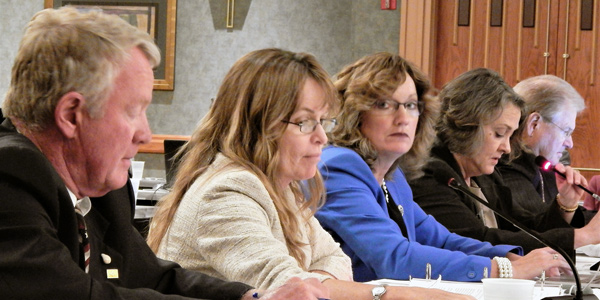RSC, OMS to Take Crack at Interregional Issues

OMAHA, Neb. — State regulators from the SPP and MISO footprints are banding together to take on seams issues created by what one industry expert calls “RTO gerrymandering.”
Commissioners sitting on SPP’s Regional State Committee and MISO’s Organization of MISO States (OMS) met Monday to begin developing a joint RSC-OMS working group to improve market coordination and tackle problems the grid operators and their stakeholders haven’t been able to resolve.
“It’s a conversation we’ve been having off and on since May,” said RSC Chair Shari Feist Albrecht, who also chairs the Kansas Corporation Commission. “We want to contribute a state regulator’s point of view to the discussion here, and to provide advice and guidance.”
OMS Chair Ted Thomas, who chairs the Arkansas Public Service Commission, and Minnesota Public Utilities Commissioner Matt Schuerger met with RSC regulators before the committee’s regular quarterly meeting. Albrecht said the commissioners discussed defining the problems and establishing goals going forward.
“It made sense to work together,” she said. “State commissions have regulatory and cost-allocation authorities. We should have a responsibility in this area.”
“We need to work together… and not bang heads,” Thomas said during an OMS Executive Committee conference call in June.
SPP and MISO have been unable to agree to any interregional projects since FERC issued Order 1000 in 2011. The grid operators have said the cost of building joint models and financial and voltage thresholds inhibit their ability to come together on projects across the seams.
The RTOs agreed last month to work on improving their interregional process. They will study potential joint projects within their own regional models and have also added new benefit metrics, such as the avoided cost of other projects. (See MISO, SPP Loosen Interregional Project Requirements.)
“If there are problems, what are they? You can’t solve problems if you don’t try,” said Albrecht, noting that MISO and PJM work well across their seam. “We don’t have a sense of history or the background behind [seams issues]. Whatever they are, they’re not unsolvable.”
Stakeholders on both sides of the seam have expressed their frustration over the RTOs’ inability to get interregional projects approved. The Wind Coalition’s Steve Gaw, one of the more outspoken critics of the process, said he is pleased by the RSC and OMS efforts.
“RTOs were formed in part because of the savings that result from reducing the costs of seams between utilities,” Gaw said. “Today we have a seam between MISO and SPP that stretches across multiple states. The states, through the regional committees, are well positioned to examine whether significant cost savings for consumers and reliability improvements could be made between RTOs.”
Ironically, it’s the shape of the SPP-MISO seam itself that has contributed to the problem. Economist Rob Gramlich, president of Grid Strategies, said without “rationally configured RTOs,” seams issues have become larger than they should be.
“FERC has allowed oddly shaped RTOs — and the states and utilities have played a part in that — but they won’t work without effective seams management,” Gramlich said, referring to the shapes as “RTO gerrymandering.”
“It’s helpful for state regulators in both regions to help resolve seams problems for their mutual benefit,” he said. “Clearly, SPP and MISO are talking to each other and trying to work things out. They’ve made a number of improvements, but somebody needs to be holding them accountable and moving the process forward.”
SPP General Counsel Paul Suskie, staff secretary for the RSC, said the grid operator is “encouraged” by the commissioners’ engagement and greater understanding of seams issues.
“It’s especially valuable when it comes to building seams projects, considering commissioners’ critical roles in cost allocation and siting authority,” he said.
Ag Study Safe Harbor Limit Stays Unchanged
The RSC unanimously accepted the Cost Allocation Working Group’s recommendation to not conduct a larger study on the aggregate study’s safe-harbor waiver criteria, following the CAWG’s first limited review. The committee also agreed that the CAWG should conduct a second limited annual review in 2019.
The committee agreed last year to conduct a limited study of the aggregate study, which assesses the projects necessary to satisfy transmission service requests to move energy around the SPP system, as well as who pays for those projects. Transmission upgrades under the safe harbor limit are base-plan funded through the RTO’s highway/byway approach. (See “RSC Leaves Safe Harbor Limit Unchanged,” SPP Regional State Committee Briefs: July 24, 2017.)
The safe harbor cost limit will remain unchanged at $180,000/MW.
— Tom Kleckner







